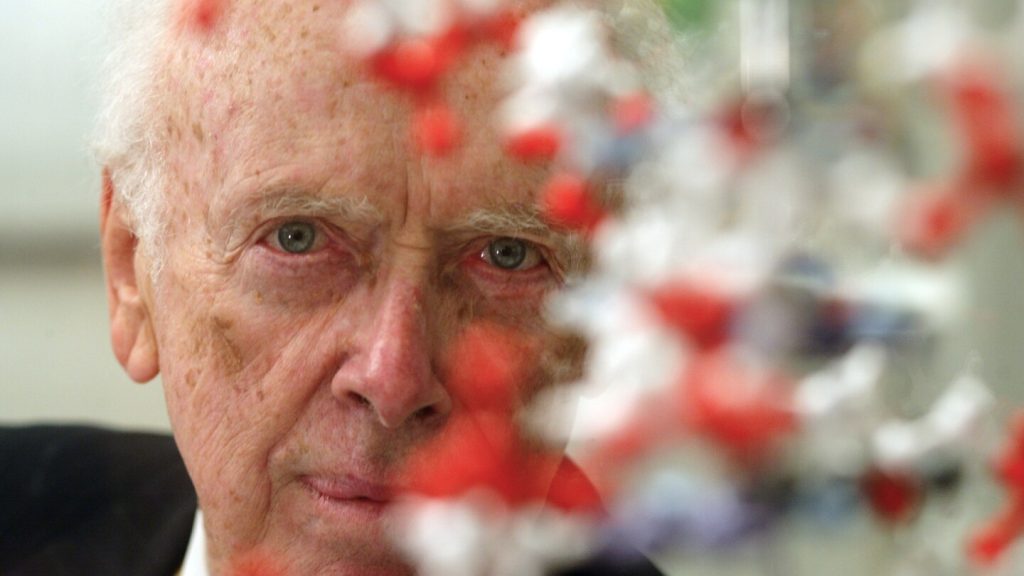Listen to the article
James Watson, DNA Pioneer Who Transformed Medicine and Science, Dies at 97
James D. Watson, whose co-discovery of DNA’s double helix structure in 1953 revolutionized medicine, forensics, and genetics, has died at age 97 following a brief illness in hospice care.
The breakthrough came when Watson was just 24 years old, working alongside Francis Crick at Britain’s Cambridge University. Their discovery that deoxyribonucleic acid (DNA) forms a twisted ladder structure with two intertwining strands immediately suggested how hereditary information is stored and replicated when cells divide.
“Francis Crick and I made the discovery of the century, that was pretty clear,” Watson once remarked. The double helix quickly became an iconic symbol of science, appearing everywhere from Salvador Dali’s artwork to British postage stamps.
Watson shared the 1962 Nobel Prize in Physiology or Medicine with Crick and Maurice Wilkins for their groundbreaking work. Their discovery opened floodgates to developments that have fundamentally altered modern society: genetic engineering, gene therapy for disease treatment, DNA forensics for criminal investigations, and genetic genealogy for tracing family histories and human evolution.
“It goes down as one of the three most important discoveries in the history of biology,” said Bruce Stillman, president of Cold Spring Harbor Laboratory, ranking it alongside Darwin’s theory of evolution and Mendel’s laws of genetics.
Born in Chicago on April 6, 1928, Watson was a prodigy who entered the University of Chicago at 15 and earned his doctorate from Indiana University at 22. His scientific curiosity was sparked at 17 when he read that genes were the essence of life. “I thought, ‘Well, if the gene is the essence of life, I want to know more about it,'” he later recalled.
After the DNA discovery, Watson wrote influential textbooks and the bestselling memoir “The Double Helix,” which chronicled the race to decipher DNA’s structure. From 1968 to 1976, he transformed Cold Spring Harbor Laboratory on Long Island into a world-renowned research center focused on cancer. He later directed the Human Genome Project from 1988 to 1992, establishing its significant ethical research component.
“He never stopped fighting for people who were suffering from disease,” said his son Duncan Watson.
Despite his scientific brilliance, Watson’s later career was marred by controversy. In 2007, he told a British newspaper he was “inherently gloomy about the prospect of Africa” because “all our social policies are based on the fact that their intelligence is the same as ours — where all the testing says not really.” These comments led to his suspension and subsequent retirement from Cold Spring Harbor Laboratory.
When asked in a 2019 documentary if his views on race had changed, Watson replied, “No, not at all.” In response, the laboratory revoked several honorary titles, calling his statements “reprehensible” and “unsupported by science.”
Dr. Francis Collins, then-director of the National Institutes of Health, noted Watson’s “regrettable tendency toward inflammatory and offensive remarks,” adding, “I only wish that Jim’s views on society and humanity could have matched his brilliant scientific insights.”
Watson’s discovery was aided by X-ray research from Rosalind Franklin, whose contributions were initially underrecognized. Today, Franklin is considered a prominent example of a female scientist whose work was overshadowed by male colleagues.
In 2014, facing financial difficulties, Watson auctioned his Nobel medal for a record $4.7 million, though it was eventually returned to him.
Watson’s complex legacy includes both undeniable scientific genius and deeply troubling personal views. He transformed our understanding of life’s fundamental building blocks while demonstrating that brilliant scientific achievement doesn’t necessarily translate to wisdom in all domains.
When once asked if any building at Cold Spring Harbor Laboratory was named after him, Watson replied simply, “I don’t need a building named after me. I have the double helix.”
Fact Checker
Verify the accuracy of this article using The Disinformation Commission analysis and real-time sources.




10 Comments
A true scientific pioneer whose discovery of DNA’s structure laid the foundation for transformative advancements in medicine, forensics, and genetics. His legacy will continue to impact the world for generations to come.
What an incredible legacy Watson leaves behind. His work on DNA was a transformative achievement that opened the door to so many subsequent advancements in medicine, biology, and genetics. A true scientific visionary.
Watson’s discovery of the double helix structure was a seminal moment that transformed our understanding of genetics and heredity. While he was a controversial figure, his scientific contributions were undoubtedly groundbreaking and influential.
Agreed. Even with the controversies surrounding Watson later in life, his discovery of the DNA double helix remains one of the most important scientific breakthroughs of the 20th century.
While Watson’s scientific contributions were immense, his later controversial views on race and intelligence were deeply problematic. It’s important to recognize both his triumphs and his flaws in assessing his complex legacy.
You make a fair point. Scientific achievements should be judged separately from personal views, even when they are as impactful and contentious as Watson’s.
Rest in peace to a true giant of 20th century science. Watson’s work on the structure of DNA was a monumental breakthrough that has had lasting impacts across so many fields. A towering figure in the history of biology.
Watson’s groundbreaking work with Crick opened up entirely new fields of study and revolutionized our understanding of the building blocks of life. A remarkable scientific achievement that has had profound implications across so many disciplines.
Absolutely, their discovery was a true milestone in the history of science. It’s amazing to think how much our understanding of biology and genetics has progressed since then.
The double helix is such an iconic and instantly recognizable symbol of science. Watson’s discovery truly revolutionized our understanding of genetics and paved the way for so many subsequent advancements. A remarkable scientific career.